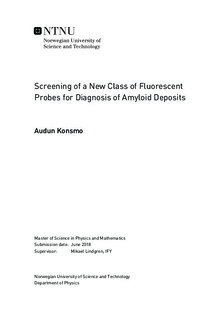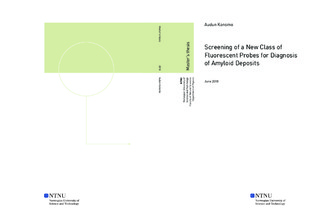| dc.description.abstract | The purpose of this project has been to determine photo-physical properties of new and untested fluorescent probes. The probes have a 2,1,3-benzothiadiazole (BTD) ring structure and are derivatives of the previously explored probe BTDSB. The probes are labelled BTD-1, BTD-2, BTD-3, BTD-4, BTD-5, BTD-6, BTD-11, BTD-12, BTD-13 and BTD-14. The probes have been designed for the detection and analysis of amyloid fibrils, which are aggregates of proteins connected to a diverse range of diseases (e.g. Alzheimer s disease, Parkinson s disease and type II diabetes).
Specifically, the lifetimes, absorption spectra, emission spectra and quantum yields of the new probes were measured with toluene as solvent. The new probes had stokes shift of ca. 100 nm or longer and their quantum yields were high (0.59-0.90), with the exception of BTD-5 (0.29). The two-photon absorption (TPA) were also investigated and interestingly, many of the new probes showed high two-photon absorption cross sections; often more than two times that of the commonly used reference fluorescein. BTD-4 and BTD-5 were especially high, and only BTD-1, BTD-6 and BTD-12 had lower cross sections than fluorescein. In addition, the probes were tested for their affinity for binding to amyloids by measuring their difference in emission with native and fibrillar insulin. BTD-1, BTD-5 and BTD-14 showed a decent increase in emission (~1.8), while BTD-2 and BTD-3 had a smaller increase (~1.4) but had a shift of around 35 nm between the fibrils and the native peak. BTD-11 had both a decent increase in emission (1.86) and a shift of 24 nm. However,the established probes, DF-9 and ThT, showed a much higher increase in emission: 14.97 and 29.27 respectively.
The new probes may still be useful for investigating insulin amyloids because of their high two-photon absorption cross sections. BTD-11 and BTD-14 especially look promising. Possible objectives for the future are to investigate the probes with different types of amyloids and, since the new probes all have lifetimes in the nanosecond range, they may be used for fluorescence lifetime imaging (FLIM). | |

